French interior and furniture designer Emile-Jacques Ruhlmann established a interior design firm, in partnership with Pierre Laurent, that is the embodiment of French Art Deco style.
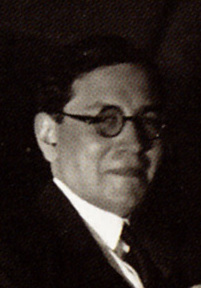
Image source: https://commons.wikimedia.org/wiki/File:Jacques-%C3%89mile_Ruhlmann_(cropped).jpg
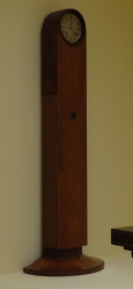
Image source: https://search.creativecommons.org/photos/590a2afe-a4ba-4215-8dcb-ed5ec7de7988 by westher
About His Life
Emile-Jacques Ruhlmann was born in Paris in 1879 into an Alsatian family in the general decorating business. Then, when his father died in 1907, he took over the family firm. In 1919, he founded an interior design company with designer and friend Pierre Laurent, the Établissement Ruhlmann et Laurent, which specialized in luxurious home goods, including furniture, wallpapers, lighting and bronze artefacts.
By this time, Ruhlmann made formal elegant furniture using exotic woods and inlays of ivory, lacquer, precious metals, and scrollwork. Then, by 1927, Ruhlmann’s shop consisted of two locations, employing twenty-seven master cabinetmakers, four finishers, a dozen upholsterers, a few apprentice cabinetmakers and twenty-five draftsmen. However, the worldwide depression, following the stock market crash of 1929, brought an end to the luxurious lifestyle for which Ruhlmann’s target audience lived. Finally, Ruhlmann died on November 15, 1933, in Paris.

His Major Works
Ruhlmann’s designs, both in France and abroad, decorated palaces, large politicians’ estates, and national museums. Today, his works are present in the permanent collections of the Metropolitan Museum of Art, the Brooklyn Museum, the Smithsonian Cooper-Hewitt National Design Museum, and the Museum of Fine Arts in Boston, among others.
The Corner Cabinet
Ruhlmann and Laurent’s furniture popularized, thanks to their opulent designs. In a contemporary key, the glories of the Parisian cabinet in the days of Louis XV, Louis XVI and the Empire inspiration is present in the pair’s pieces. In addition, their works often used similar precious techniques and materials. For example, the corner cabinet is made using kingwood (amaranth) veneer on mahogany and inlays of ivory.
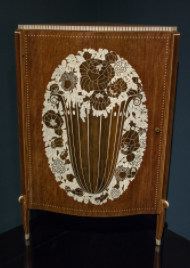
Image source:https://search.creativecommons.org/photos/34f30bd9-aedd-46da-b57b-4cd0922dc398 by Tim Evanson
Fuseaux Cabinet
Designed and manufactured from 1920 to 1949 in France, by using rosewood and ivory. Only seven copies of this small cabinet are known to this date, including one at the Metropolitan Museum of Art in New York, and one at the Musée des Beaux-Arts in Lyon. Both were already acquired directly from Ruhlmann in 1925, on the occasion of the major art trade exhibition in Paris. For the production of one of the cannulated legs alone, about 50 working hours were required. This table was manufactured circa 1921.
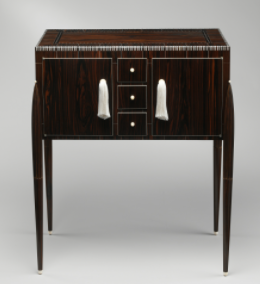
Image source: https://commons.wikimedia.org/wiki/File:%22Fuseaux%22_Cabinet_MET_DP106271.jpg
Ruhlmann’s Style
Once, Emile-Jacques Ruhlmann said, “to create something that lasts, the first thing is to want to create something that lasts forever.”
His early designs reflected the popular Art Nouveau influences in France at the turn of the century. Later, his influences could be traced back to architects and designers who created innovative furniture in Vienna around the time of the First World War.
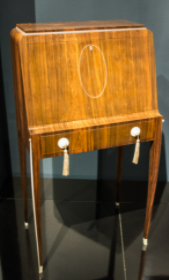
Image source: https://search.creativecommons.org/photos/70ed6f9b-e069-4ec0-a8f0-8cb9455875f0 by Tim Evanson
Its strongest inspiration could come from the classic design elements and craft ideals found in 18th century furniture: Ruhlmann would then model these same ideals in what he called his precious pieces. The hallmarks of these early works were their almost imperceptible curves and elegantly subtle uses of ivory. These pieces were more often embellished with ivory, which gave a static sense of control to the pieces that made them unique, timeless and extremely elegant. Over time, however, his style became more functional and modern, and occasionally even modular. His two favorite woods, Macassar ebony and amboyna root, create both soft but surprising patterns, without focusing on the wood itself.
Info sources:
http://ruhlmann.info/e-j-ruhlmann/
https://www.widewalls.ch/artist/emile-jacques-ruhlmann/
https://www.pamono.com/fuseau-cabinet-by-jacques-emile-ruhlmann-1920s
